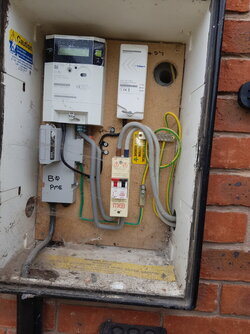E
Edward67
Hi ok here we go.
Friend has asked if can rewire his garage as he is turning it into a gym. I said ok no problem.
He the put the spanner in. Ok I want
1 circuit for a car charger. 7.4kw.
2 x 3kw heaters
1 x ring main for gym equipment. From what i can tell running machine is most power hungry.
1 x lighting circuit.
All on a 2.5mm incoming swa.
So now I need to split the meter tails.in the cupboard and put in 25mm swa cable. Run about 12 meters.
Pme 80amp.
So looking for thoughts.
He needs cutout upgrading to 100amp. Its large 5 bed already with a hot tub.
Do you think I should install 2 core swa and TT the garage.
Or 3 core swa to mini board in meter cupboard then to isolator.
Or a two core swa with separate earth cable run next to it. This is better as earth can be smaller diameter.
Due to the size of the earthing conductor with the mini boards even accept them.
Or thinking outside the box. I could run the swa and terminate to a metal bracket mounted in the meter cupboard then run into a double isolator switch which will protect the current house tails and new swa tails.
The issue with this is the tails from the bracket to isolator are not double insulated.
However they are In cupboard that requires a key to enter so does that comply. I'm not sure.
I already know about the debated exporting pme conversation so don't wish to revisit it please.
Looking for ideas or pictures of people who have performed this.
If it wasn't for a friend I would refuse because sometimes it's best to DGI.
All comments appreciated.
Pic.of meter cupboard attached. Mmmm loads of space? think there is room for mini board.
Friend has asked if can rewire his garage as he is turning it into a gym. I said ok no problem.
He the put the spanner in. Ok I want
1 circuit for a car charger. 7.4kw.
2 x 3kw heaters
1 x ring main for gym equipment. From what i can tell running machine is most power hungry.
1 x lighting circuit.
All on a 2.5mm incoming swa.
So now I need to split the meter tails.in the cupboard and put in 25mm swa cable. Run about 12 meters.
Pme 80amp.
So looking for thoughts.
He needs cutout upgrading to 100amp. Its large 5 bed already with a hot tub.
Do you think I should install 2 core swa and TT the garage.
Or 3 core swa to mini board in meter cupboard then to isolator.
Or a two core swa with separate earth cable run next to it. This is better as earth can be smaller diameter.
Due to the size of the earthing conductor with the mini boards even accept them.
Or thinking outside the box. I could run the swa and terminate to a metal bracket mounted in the meter cupboard then run into a double isolator switch which will protect the current house tails and new swa tails.
The issue with this is the tails from the bracket to isolator are not double insulated.
However they are In cupboard that requires a key to enter so does that comply. I'm not sure.
I already know about the debated exporting pme conversation so don't wish to revisit it please.
Looking for ideas or pictures of people who have performed this.
If it wasn't for a friend I would refuse because sometimes it's best to DGI.
All comments appreciated.
Pic.of meter cupboard attached. Mmmm loads of space? think there is room for mini board.











